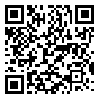Fri, Dec 12, 2025
[Archive]
Volume 14, Issue 4 (9-2024)
J Adv Biomed Sci. 2024, 14(4): 301-309 |
Back to browse issues page
Download citation:
BibTeX | RIS | EndNote | Medlars | ProCite | Reference Manager | RefWorks
Send citation to:



BibTeX | RIS | EndNote | Medlars | ProCite | Reference Manager | RefWorks
Send citation to:
Shalbafan M, Sadeghpour M, Olyaei A. Glide Docking for Prediction of Potential Inhibitors of ATP7B Protein in Wilson Disease. J Adv Biomed Sci. 2024; 14 (4) :301-309
URL: http://jabs.fums.ac.ir/article-1-3092-en.html
URL: http://jabs.fums.ac.ir/article-1-3092-en.html
1- Department of Chemistry, Faculty of Science, Imam Khomeini International University, Qazvin, Iran
2- Department of Chemistry, Qazvin Branch, Islamic Azad University, Qazvin, Iran ,mahdieh.sadeghpour@qqiau.ac.ir
2- Department of Chemistry, Qazvin Branch, Islamic Azad University, Qazvin, Iran ,
Abstract: (1493 Views)
Background & Objectives: Wilson’s disease is a genetic disorder marked by the pathological accumulation of copper in the liver and brain due to malfunctioning of the ATP7B protein. This study employed virtual screening and glide docking techniques to explore potential therapeutic agents targeting ATP7B using natural compounds from the ZINC15 database.
Materials & Methods: A virtual screening protocol was implemented to rapidly identify promising drug candidates with inhibitory activity against ATP7B. The glide docking program (Schrödinger Maestro 2018-1) was used to screen natural compounds, followed by ADME analysis to assess drug-likeness and pharmacokinetic properties.
Results: Three lead compounds—Tobramycin, Streptomycin, and Metyrosine—were identified with the most negative G-scores and docking scores among screened compounds, signifying strong binding affinities for ATP7B. Tobramycin showed superior performance with a glide score of -6.426, accompanied by favorable ADME properties and high similarity to the reference ligand, oxaliplatin.
Conclusion: Tobramycin was identified as a promising candidate for therapeutic intervention in Wilson’s disease, exhibiting robust binding affinity to ATP7B and drug-like characteristics. Future experimental studies are necessary to validate its clinical potential and safety.
Materials & Methods: A virtual screening protocol was implemented to rapidly identify promising drug candidates with inhibitory activity against ATP7B. The glide docking program (Schrödinger Maestro 2018-1) was used to screen natural compounds, followed by ADME analysis to assess drug-likeness and pharmacokinetic properties.
Results: Three lead compounds—Tobramycin, Streptomycin, and Metyrosine—were identified with the most negative G-scores and docking scores among screened compounds, signifying strong binding affinities for ATP7B. Tobramycin showed superior performance with a glide score of -6.426, accompanied by favorable ADME properties and high similarity to the reference ligand, oxaliplatin.
Conclusion: Tobramycin was identified as a promising candidate for therapeutic intervention in Wilson’s disease, exhibiting robust binding affinity to ATP7B and drug-like characteristics. Future experimental studies are necessary to validate its clinical potential and safety.
Type of Study: Research |
Subject:
Pharmacology
Received: 2024/08/3 | Revised: 2024/12/21 | Accepted: 2024/11/26 | Published: 2024/12/21
Received: 2024/08/3 | Revised: 2024/12/21 | Accepted: 2024/11/26 | Published: 2024/12/21
Send email to the article author
| Rights and permissions | |
 |
This work is licensed under a Creative Commons Attribution-NonCommercial 4.0 International License. |

This work is licensed under a Creative Commons — Attribution-NonCommercial 4.0 International (CC BY-NC 4.0)




